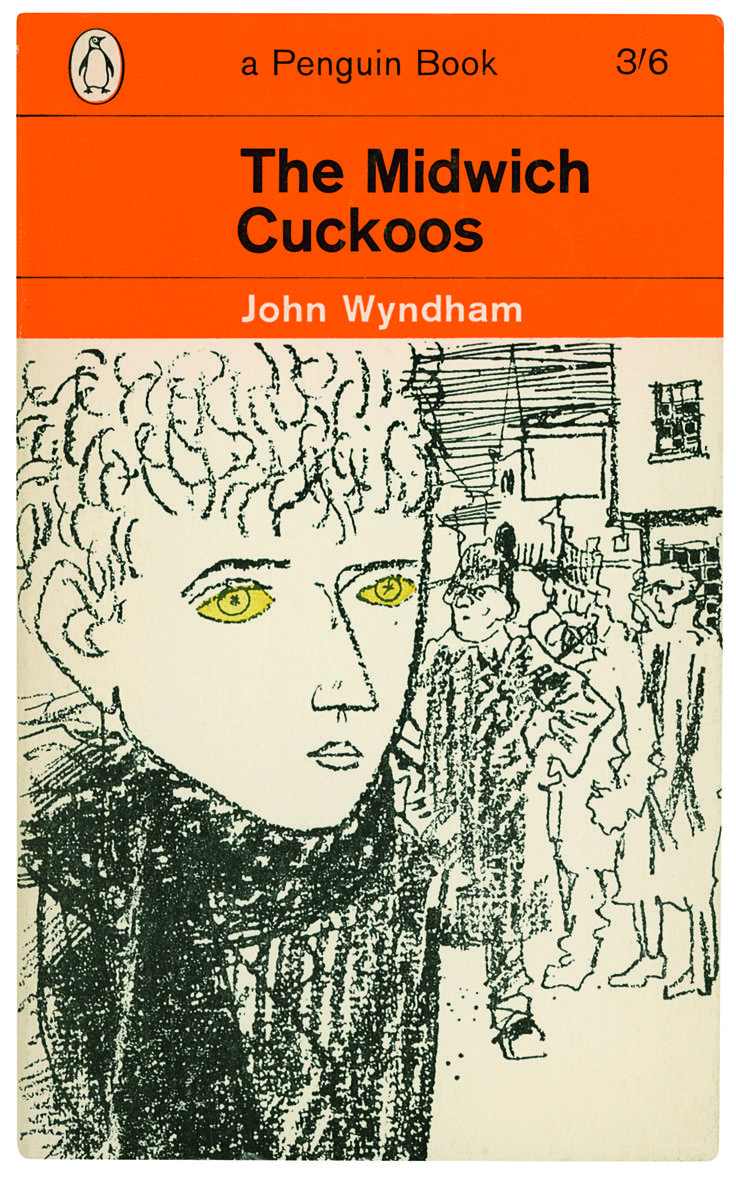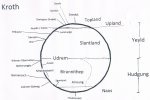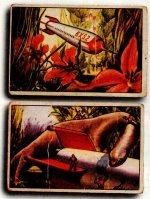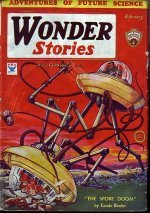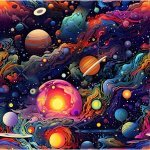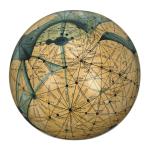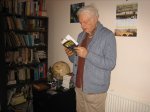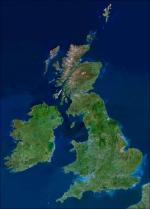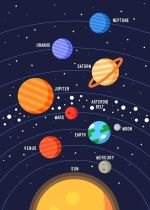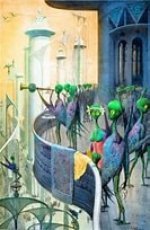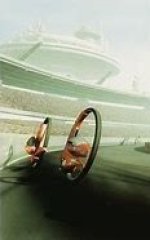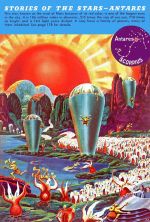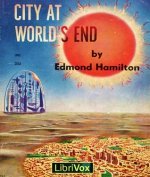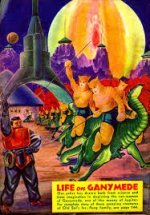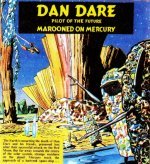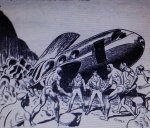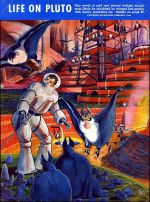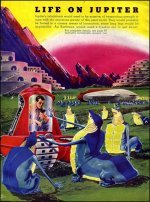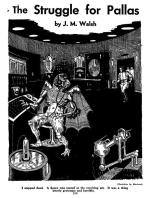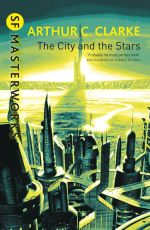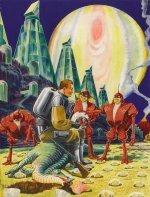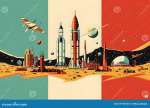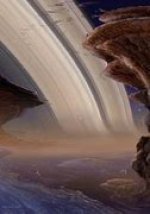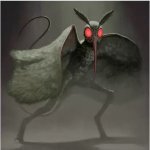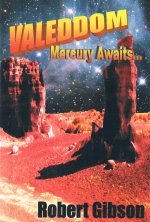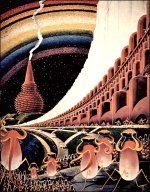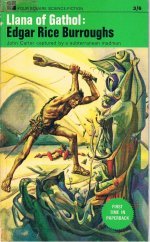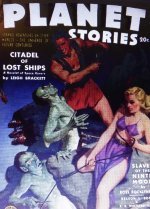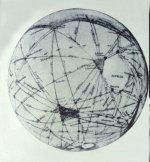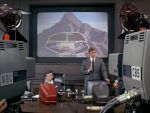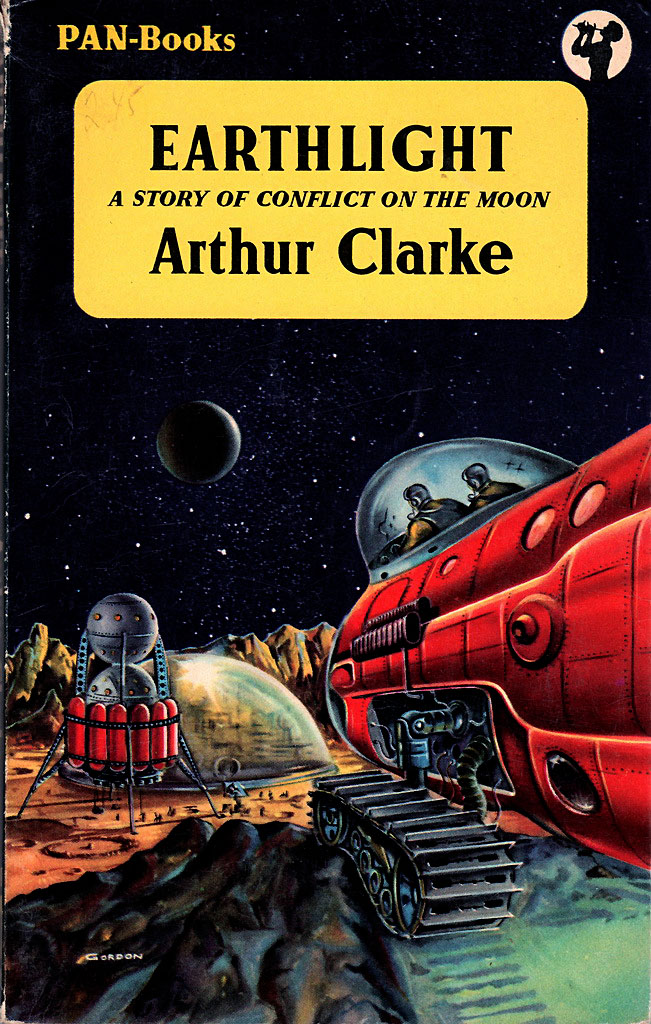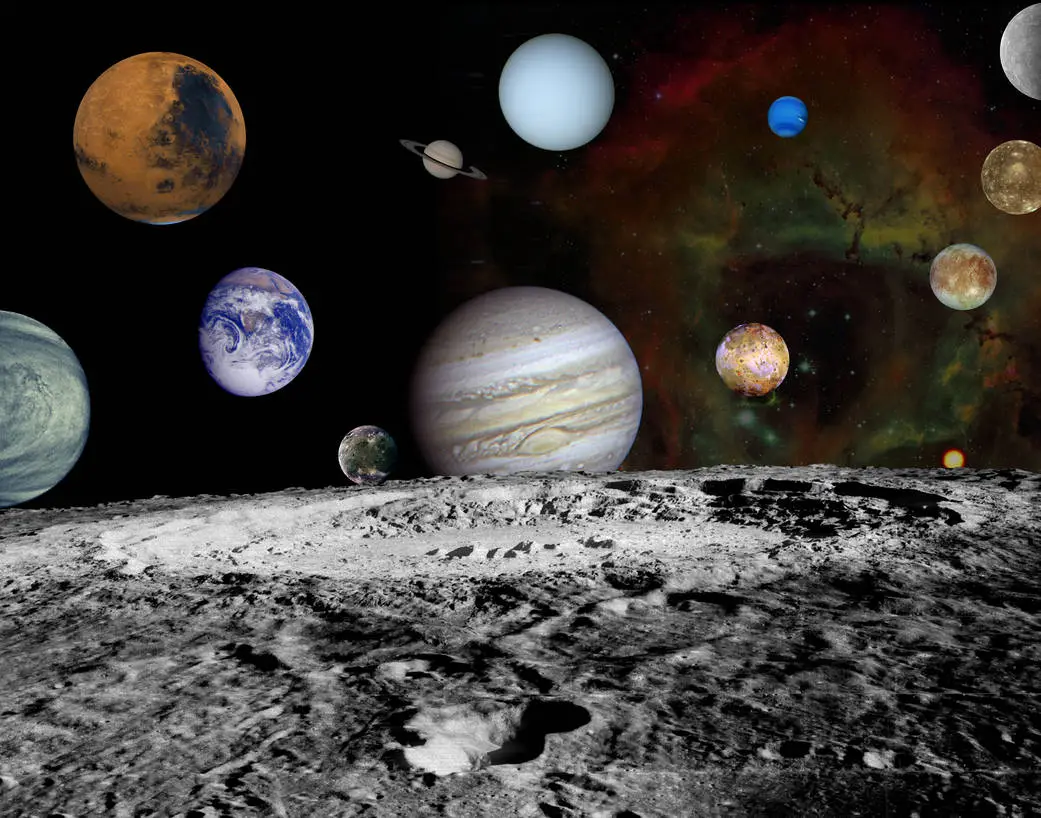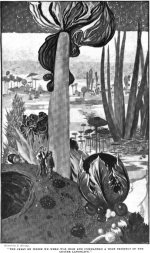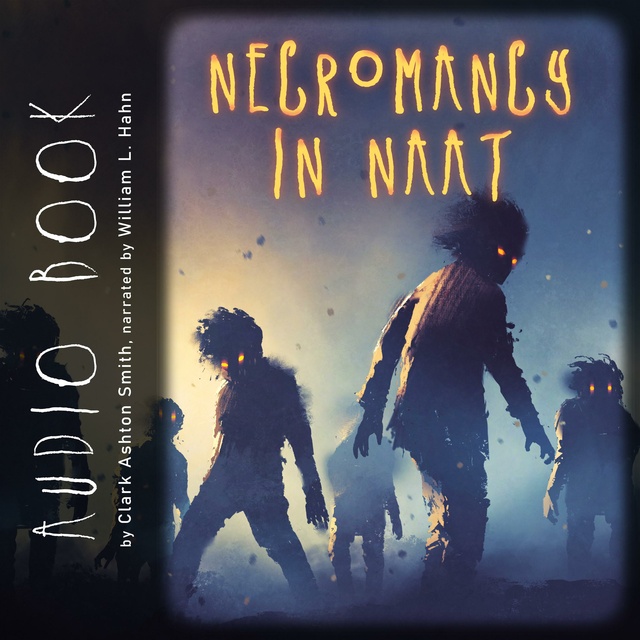a survey of
ooranye
[ + links to: An approach to world-building - A Brief History of Ooranye - Glossary/Reference - Maps - Uranian Eras - Uranian Gleams - Uranian Throne ]
The material on this page is based upon contents transferred from the old website www.ooranye.com, which I intend to phase out. But that probably won't be all: as time goes on it's likely that further additions will show up here.
Contents of this page:
Physical Planetography
size and area - day and night - the two hemispheres - the interior -
plains and mountains - environmental change
Life-forms
Flora
the narps - the katora - the vheic
Fauna
the eopc - the fdalm - the mareks - the mawos - the rebexa - the umbna-jorraynt -
the velng
Clouds
the zicena - the evidencer clouds
Microscopic life
The Uranian firmament - a clash of sources [note: this section has been placed here because of its connection to the biosphere glow]
Intelligent life (1) The Nenns
Cities
the disc-on-stem cities -
Ao - Grard - Hoog - Ierax - Innb - Invun - Jaax - Jador - Juxxt - Linnt - Lysyon - Narar -
Nemyurur - Nuvium - Oso - Pjourth - Skyyon - Toolv - Tva - Vlamanor - Vyanth - Xydur -
Yaz - Yoad - Yoon
the cities of Oirr -
Arn - Contahl - Soolm - Vus
Starside cities: the freightshuttle exits, fleet remnants and the "Other Syoom" -
Deev, Karth, Koar, Nusun, Olhoav, Poleva; Yalar and Nii
Allv, Yr, Vlonn and the dubious
Institutions
the noadex and the dayonnad - the sunnoadex - various named sunnoads - correctors -
other institutions - military ranks and units
Languages
Mentality
teleology - acceptance of mystery - the problem of evil - apparng - renl
Names
Units of measurement
Cartography
Intelligent life (2) Non-human intelligences
Gedars - kalyars - Quonians - Ghepions - Nemaeans - sentient cities - the World Spirit -
transient species
introduction
Ooranye: a world of ancient civilizations, both human and non-human; of epic voyages, wonder and adventure; a world with its own distinctive dreams, ideals, philosophies and institutions; its own ecologies and multifarious forms of life...
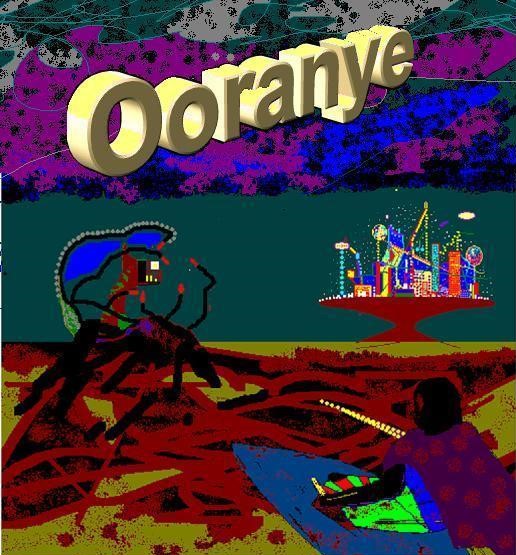
Uranus was its former name, given it by the people of Earth. The adjective "Uranian" is still in use, but the noun fell into disuse on the day of the mysterious so-called Fostering. On that fateful Tenth of July, A.D. 3564, action carried out by Terran reality engineers caused the planet's truest nature to surface in our continuum: whereupon Uranus was rightly revealed not as a lifeless gas-giant but as the solid, inhabited world named by its natives Ooranye.
This "surfacing" was retrospective: once it had happened, it had always been.
(For the background to this event, see "Uranian Thule", in Vintage Worlds (2018), ed. John Michael Greer and Zendexor.)
And because of the retrospective effect of the Fostering, we may truly say that civilization on Ooranye predates that of Earth by approximately 1,200,000 Terran years.
physical planetography
size and area
Ooranye is 25,011 miles in diameter. This is not quite as big as what used to be called Uranus; the Fostering resulted in some shrinkage as the planet's former gaseous nature was upgraded to its truer, more solid identity. But a reduction in diameter from 31,764 to 25,011 miles still leaves us with a colossal world. Ooranye's surface area, which is mostly land, is 1,965,223,665 square miles, about ten times the surface area of Earth, and over thirty times the land area of Earth.
Ooranye is a perfect sphere; unlike the Earth, of which the polar diameter is 27 miles less than the equatorial.
Despite being one of the distant outer planets, Ooranye has an axial rotation that appears to be tidally locked, so that its solar day and solar year are the same. Terran scientists remain puzzled as to why this is. Perhaps tidal drag is not the cause; we know very little about the history of Ooranye's previous Great Cycles, i.e. before the start of era 1 of the present Cycle, 1,200,000 Terran years ago, and we have to allow the possibility that the present set-up was artificially created by some super-civilization of the distant past.
day and night
Ooranye's solar day/year is not much use; firstly because it is so long - 84 Terran years, which amounts to a lifetime - and secondly because in any case the Sun only gives the seventh planet about 1/400th of the light it gives Earth.
Therefore, the term "day" on Ooranye is not employed in the astronomical sense.
Instead, "day" on the seventh planet is biological: it denotes the thirty-hour cycle of the brightening and darkening of the air, caused by the periodic brightening and dimming of aerial micro-organisms which are known as the throom.
The throom, be it noted, not only pervade the Uranian atmosphere, but are also present in the tissues of much of the planet's plant-life: in particular the vheic, which furnish the energy for skimmers' fuel-phials.
One great advantage of the throom as a source of time-keeping is its simultaneity. The bio-generated pulsation of light and dark is on the same hour at every longitude, which means that all Uranian clocks are synchronized over the entire globe, and so there can never be any need for "time zones" on that fortunate planet.
For the divisions of the Uranian day, see the diagram-page, Uranian Clock.
The problematic topic of the Uranian night sky, because it is so related to the topic of the throom, is discussed just after the section on microscopic life; see The Uranian Firmament - A Clash of Sources.
the two hemispheres of ooranye
As is natural for a world which has one side always facing the Sun, Ooranye's significant hemispheres are held to be, not the northern and the southern, but the Sun-facing and the other - or, as the Uranians call them, Sunside and Starside.
The Sunward polar city, Skyyon, is the cultural centre of Syoom, an area coterminous with the main bloc of Uranian civilization. Antipodeal to Skyyon is the Starside polar region, the mysterious, legendary land of Arclour. (For the momentous expedition to Arclour which inaugurated the Final Era, see Uranian Thule.)
the interior of ooranye
The planet's ice mantle extends most of the way down to the core. The core itself, and many moon-sized globules within the mantle, consist of denser mass-concentrations ("mascons"). These can be of degenerate matter - as abnormally dense as that found in white dwarf stars, only cold; or of the pre-universe non-particulate matter called kolv; or of gvo, which is a compound of kolv and particulate matter. Occasionally, with the slow convection of aeons, a mascon may find its way to the surface and emerge as the tip of a globular mountain. One of these, the so-called "Sun-Egg", played a key part in history (see The Lithium Era). At a much later period, the Bismuth Era, there was a vogue for exploring the density-globes by diving down into the mantle itself, by means of a form of travel that employed molecular interpenetration. (See The Mascon Expeditions.)
the plains and the mountains
The characteristic Uranian landscape is that of an immense plain. That sense of awe and mystery which on Earth is aroused by its oceans, on Ooranye is aroused by the solid world-ocean, the endless ice-plain.
The ice, however, usually does not appear on the surface, which is generally covered by a layer (a yard deep at most) of a semi-organic granular substance, known as gralm.
Although plants can grow in it, gralm has nothing in common with Earthly loam, either in texture or in appearance. Gralm is corky, slightly springy to walk upon, and of varied cold colours - greys, blues, purples and browns.
Perhaps two per cent of the plains are covered with isolated forests, and in addition to the forests there are innumerable solitary groves, some of them formed by deadly narps, the long-lived weeds with laser-tipped stems, who can live for millions of days on the metal carcass of one downed skimmer.
Other breaks in the world-embracing plain are formed by "islands" of hilly or mountainous territory, and some huge chasms. The Mountains of Flame beyond the city of Pjourth cover thirty million square miles and include peaks twice as high as Everest.
The greatest physical mark made by man to the topography of the plains consists of the mighty monorail network built in the Zinc Era. Around 150,000 miles of track were laid down, upon embankments seven yards high.
Finally we may note the rare "seas", actually giant lakes, whose slow-motion waves have been known to conceal submarine monsters and - on one occasion - monster submarines.
Environmental change
The giant planet Ooranye is much less vulnerable than is the comparatively fragile Mother Earth. Ooranye can look after itself; hence there has never been any need for Uranian "environmentalism": that pest Mankind cannot damage the seventh planet in the way that he has damaged the third. Uranian humanity ("Nennkind") flourishes up to a point, but is never in any danger of dominating the colossal, dim, mysterious world, of which the physical challenges are too great to master, and which besides has to be shared with intelligent powers greater than he.
Nature herself is less prone to violent change on Ooranye than she is on Earth. Apart from the slow convection which occasionally brings a mascon to the surface, the giant planet is mostly quiescent. The "cold volcanoes" of Jersh pour forth liquid water rather than lava, and even those low-key eruptions are mostly delayed consequences of the events which ended the Bismuth Era.
However, that last point must count as an admission that in certain exceptional cases humans have had a discernible - though never irreversible - effect on the Uranian environment.
We refer the reader to Impostor for the crime of Nehal Fozdak, who incited mascon life-forms to damage the world's surface with their ultra-dense bodies. And we must mention two other exceptions to the generally stable picture of the relations between world and man; both of these events are also covered in the History..
The first of these disasters was the Great Winter of the Titanium Era, which covered most of the civilized world in snow. The second disaster was the "Foam" - the popcorn-like expansion of the gralm in the Lanthanum Era, which, even more deeply than the snow had done, covered the main cities of Syoom. The Great Winder was retaliation by Fyayman powers for Nalre Zitpoidl's act of murder. As to the Foam, we understand the physical mechanism involved but we do not know why it occurred when it did, and the possibility remains that human action was a contributary cause.
life-forms
the flora of ooranye
Not quite so rich in species as is Earth, Ooranye can nevertheless boast an impressive flora, especially when one considers its distance from the Sun. Many of the forests which clothe two per cent of the plains consist of trees 150 or even 200 yards high, of varied species and shades of blue and green. Some other areas of plain and hilly country are covered with scrub and/or moss.
the narps
These are perhaps the most dangerous plants on the planet. They can live for millions of days, and seem, for most of that time, motionless; when, however, a wayfarer skims unwisely close, the narp's laser-tipped stem can aim and fire, so that during the next few tens of thousands of days the plant gathers in the wreckage with sweeps of its leaves, to ingest it in its acid-oozing core.
the katora
The rare katora groves have sometimes been regarded as sacred to the World Spirit. In actual fact the intelligence haunting them is purely that of the katora themselves. Spiky, like Terran hawthorns, they are apt to tremble sometimes when the wind is not blowing. It is believed that during this Great Cycle they are, and will remain, in a kind of trance. Hardly anything is known of them, but this lack of knowledge is combined with a conviction that when one stands in a katora grove one is in the presence of a secretive, telepathic intelligence. And as a light-ray may bounce off an inert mirror, so it has happened that a vital fact has been transmitted, passively, by the katora.
the vheic
These are the glowing ell-light plants, the fuel or energy plants, which are cultivated in the fields around the cities of Syoom.
Their natural glow normally pulses in a thirty-hour cycle, following the rhythm of the throom. Brightening the cities' surrounding zones with golden territory, the vheic are harvested in rotation and compressed into fuel for vehicles and for static machinery of every type. Furthermore, vheic-phials provide backing for the currency system. Without the vheic, Uranian civilization would grind to a halt.
Up until era 7, vheic could only be used in its uncompressed form, as a relatively inefficient fuel, or for lighting. Successful experiments in the use of compressed ell-light for power were first carried out in era 7, the Nitrogen Era. The phials - a kind of standard fuel-cell - came into widespread use in era 10, the Neon Era.
A historical note regarding fields of vheic: in most eras they have glowed a rich gold (there is also a less widespread blue variety). But in the Praesodymium Era, Era 59, they glowed an especially beautiful wan orange, a beauty which signalled decline, because after the disaster of the Foam the weakened plants emitted at longer wavelengths. (In parallel with this change, human society henceforth displayed the social distinction between foregrounders and backgrounders - as if Fate in its own mode were reflecting an exhausted ecology.)
the fauna of ooranye
The tenet "Form follows function" does not always apply to Uranian life-forms. Although many of the characteristics of Ooranye's fauna can be understood by reference to evolutionary processes and environmental needs, such analysis breaks down when one attempts to understand a crystallized nightmare such as the lathokna. This is a major difference between Ooranye and Earth. It may be due, at least in part, to the fact that some so-called animals on Ooranye are degenerations from what were intelligent species in previous Great Cycles.
Being thus harder to study and analyze, Uranian fauna are less predictable than Terran. This tends to make them more dangerous. Another cause of danger to wayfaring man, is the length of some predators' metabolic cycles. Creatures which can freeze in stasis for tens of thousands of days between meals, can be all the more ferocious when they awake.
(In the list below, the classification "fauna" in some cases is uncertain. For example the eopc and the velng may belong in the category of Intelligent Life, and conversely the zicena may not be alive at all.)
the eopc
This is a giant bird, with a wing-span of up to seventy yards. It is the largest known winged creature on Ooranye. It does not eat or drink, and the mystery of whence it obtained its energy led the researchers of the Rin-Stazel to discover the dimension called Chelth.
the fdalm
This is a wedge-shaped burrowing creature which creates ice-caverns under the plains. Its accordion-like plasticity enables it to insert itself into cracks in the ice and then to split them further. Thus it enlarges its subsurface space.
the mareks
This strange animal has a purely accidental resemblance to a human head. Its circle of thin legs support its cephaloform body, which, when the "cheeks" are puffed out, is ready to kill its prey with sound.
the mawos
A much larger relative of those aerial micro-organisms known as the throom, the mawos are wardrobe-sized and wardrobe-shaped, albeit fuzzy at the corners and light enough to drift on the wind. (In the earlier, sessile rooted-vegetable stage of its life, the mawos is called a vrayn.) Mawos avoid the presence of man, but nevertheless pose a danger, in that if left alone they will eventually block off huge areas of sky, crowding out the throom on which other living things depend for light. This was a serious problem during the Lithium Era but since then mawos have become fewer and the airship-patrols which restrain their spread have become far less expensive to maintain.
the rebexa
A large, semi-intelligent bird with a long beak and yellow teeth. Rbexaou vary in side from fifteen down to five feet tall.
the umbna-jorraynt
The "jorraynt" end is a plant, the "umbna" end is an animal, and they are joined by an organic cable. The direction of energy flow along this cable depends on which component of this double organism happens to be contributing the most - whether it be the root system of the jorraynt, or the umbna's devouring of prey. Usually the jorraynt provides for both ends during periods of stasis. During brief orgies of meat-eating, the umbna repays.
The umbna may eventually snap the cable and live thereafter as an independent creature.
The umbna is a crablike monster the size of a Terran military tank. The body-pattern, with its arrangement of arms and pincers, differs markedly from individual to individual, perhaps due to influence from the jorraynt - plants having more individual variation than animals.
the velng (singular: vellg)
This is the ant-like race which builds artificial mountains and has been known, especially in the Vanadium Era, to hold humans captive.
the clouds
Clouds more often than not are living beings on Ooranye, some of which are sentient. Of these, some are possibly intelligent, but the question is so uncertain that this Survey deals with the clouds here rather than in the section below on intelligences. (Nenns who claim to be "cloud-talkers" have not always been believed, though, on the other hand, the alliance or symbiosis of some clouds with Yr, City of Mists, may suggest conscious co-operation.)
the zicena (singular: zice)
Possibly alive, though not organic, zicena are Ooranye's lowest and hardest clouds, accreting crystals from the winds they summon. Zicena are crystal carpets formed from millions of inch-scale tetrahedra, floating at high speed exactly five yards above the ground. Fortunately rare, when they appear they pose a huge danger to transport on the plains. Notoriously, in the Nemuran War, the surprise offensive was launched under cover of zicena.
the evidencer-clouds
The sigaklya are an animate cloud species which can collect and preserve visual recordings of events. In a form of treasure-hunting, skyships and their crews are sent to capture them, so as to sell the valuable records to historians.
microscopic life
As explained elsewhere, the cycle of day and night on Ooranye depends not on the light of the Sun, which is faint and constant: faint, due to the planet's enormous distance from that body; constant, since Ooranye keeps the same face constantly towards the Sun.
Instead, therefore, of Earth's rotational day-and-night, the Uranian thirty-hour diurnal period is governed by a cycle of atmospheric brightening and dimming, a fluctuation caused by the pulsation of light in micro-organisms suspended in the air.
This means that all Uranian clocks are synchronized: it is the same hour o'clock everywhere on the globe. On that fortunate planet there can never be any need for "time zones".
The micro-organisms responsible for this state of affairs do not predate the current Great Cycle, though other similar ones may have existed before. The current ones have two names, the throom and the bneen. Why two names? Because, in the early days, in era 1, primitive man believed there must be two forms of life, one to bring the light of day (the throom), and the other to cause the blackness of night (the bneen). Nowadays, when the process is understood, there is no scientific need for the word bneen, but in ordinary non-scientific language the term persists, laden with associations as in descriptive phrases such as bneen covered the land and proverbs such as bask in the throom but remember the bneen.
The throom is at its brightest
during the five hours of ayshine, and at its
darkest - opaquely dark - during yyne, the darkest
hour of night, when it obscures the Sun and stars, rendering the
sky utterly black. Midway between ayshine and yyne there
are a few enthralling minutes (those of refelc
at the boundary of pallyne and morningshine, and of pmetn at the boundary of evenshine
and anyne) when the throom is transparent,
allowing some stars to be seen, even in the sunward hemisphere sky,
except those that are right up close to the Sun's position.
(Of course it is only from Farside - in the starward
hemisphere sky - that refelc and pmetn reveal the heavens in all their true glory. That is
a great part of the romance of the wilds of deep Fyaym. Many
voyagers have sought a proper sight of the stars.)
Having evolved at the same time as the first humans - having emerged from the same prebiotic lake as mankind - the throom retain an odd resonance with the human racial unconscious. Widespread, exceptional human emotional surges, such as accompany rare and decisive historical events, are apt to cause irregular fluctuations in the throoms' cycle of pulsation, and so can cause interruptions to the regular thirty-hour rhythm of day and night. These interruptions, these irregularities, are called eomasps, and they mark the transition between one era of history and the next.
the uranian firmament - a clash of sources
The night sky of Ooranye is a topic which has given rise to some controversy among scholars.
The sources agree that, in the skies of Sunside, only during the minutes of pmetn and refelc can the starry firmament be seen. But what of Starside?
According to Uranian Thule, there is, antipodeal to the Sunward pole at Skyyon, a "hole" in the throom layer over the region of Arclour, from which the stars can always be seen. But apart from that most remote and special region, the rest of Starside is under the same atmospheric blanket of throom as Sunside, and reveals the stars only during pmetn and refelc, although during those minutes the stars are brighter than they are on Sunside.
However, in the much earlier story of The Worm of Poleva it seems to be implied that the firmament is visible from anywhere on the Starside hemisphere, and not just from Arclour.
This would appear to be a clear contradiction in the published sources. However, one possible solution to the problem refers back to the fact that both men and throom emerged at one and the same time from the prebiotic Lake of Dmara at the start of Era 1. This being so, it follows that just as Uranian mankind - the Nenns - took time to spread out from Dmara, the same must be true of the throom.
Now the differing accounts begin to make sense. The Worm of Poleva is set in the Niobium Era, era 41, which is long, long before the modern events of Uranian Thule. We can believe that back in era 41 the throom may well have been confined to Sunside, or at any rate it had not yet spread as far into Starside as the city of Poleva.
It is a possible answer. It is the only one we have.
intelligent life (1) - the nenns
On Ooranye the human species which most resembles us is that of the Nenns. Individually they would pass for Earth people as far as appearance is concerned, except that their skin is steel-grey. Their lifespan is approximately the same as ours: on average one Uranian year, or 84 Earth years.
However, in the mass, statistical differences soon become apparent. Judging by our standards, we Earthlings have to admit that strength and good looks can realistically be taken for granted among the Nenns, as are their almost complete freedom from disease and from the uglier ravages of old age.
Perhaps from our point of view the most startling thing about the Nenns is their absolute certainty of limited reincarnation. A Nenn knows that nen has two or three lives. Never more than that; but that much is guaranteed. The lives of an individual are almost always widely separated in time. During the second life (hardly anyone has yet attained a third) the first life is remembered, in a manner dreamlike and somewhat hazy like an old blurry photograph, but nevertheless in a mode which imparts real information.
The next most startling aspect of Nenn nature is its lack of meanness and vulgarity. Nenns can do evil, but they are free from Terran-style grossness, pettiness, perversion and pusillanimity. There is apt to be a certain grandeur to Uranian villainy, when it occurs. On the other hand, due to the differences in the way in which cause and effect operate on the two worlds, Uranians face some moral problems from which Terrans are free.
We now provide, from the Nenn point of view, some notes on the human geography of Ooranye.
cities
[ + link to sentient cities ]
It is believed that a majority of Nenns live in cities - though the rest, a considerable number, live in smaller settlements or isolated homes.
the disc-on-stem cities
The great cities - the ones that naturally come to mind when we think of the stories which come from that world - are the twenty-five mighty disc-on-stem structures which date from the Phosphorus Era.
Their like could not be built today: they were constructed using power looted from Chelth, another dimension, during a brief window of opportunity before the extradimensional tap was turned off by the indignant beings at the other end.
The stem and upheld floor of these cities are built of ultimate metal, called iedleis., which, immune to natural processes of decay, will last as long as the Universe.
It needs to be remembered that there are some famous Uranian cities which are not of the disc-on-stem structure, and which instead rest upon the ground: for example Contahl in Syoom, and the settlements on Starside such as Poleva and Olhoav, and Yalar and Nii in "the other Syoom". Dmara, beside the dried-up lake where Nennkind began, is a town rather than a city. These are all hugely important. Nevertheless, no urban spectacle can equal the stupendous sight which a classic disc-on-stem city presents to the Wayfarer who approaches it from the plain.
"A huge tray piled high with lights and held aloft by a stem" - the tray being a circle miles in width and the concave stem at least fifty yards high - the ensemble perpetually coruscates as skimmers rise and fall in double filigrees of aerial traffic-lanes, entering and exiting via the three ayashou (air-streams) spaced at 120-degree intervals around the city's rim.
The 25 disc-on-stem cities are:
Ao
One of the greatest cities. Together with Vyanth and Skyyon, it formed the "Great Triangle" alliance which, during the Osmium Era, patrolled the lands between them, giving an outstanding period of peace and prosperity to this sizeable patch of Syoom.
One hundred million days before the Great Triangle, Ao had played a different role, a lone role, unique in history. Era 54, the Xenon Era, is known as the time of the Last Great Hive. For over one and a half million days it was the most successful of hive-minds. It managed to combine the freedom of the individual with the group consciousness of a sentient city, to a degree that was never achieved before or since.
Ao is one of five cities which can trace its name, though not its physical identity, back to a settlement in the Hydrogen Era which existed close to its modern site.
Some narrative featuring the city is to be found in Confluence at Ao.
Distances from Ao to some other cities, in miles: Contahl, 7,787; Dmara, 4,260; Hoog, 5,724; Innb, 3,967; Jaax, 2,396; Pjourth, 7,321; Skyyon, 5,723; Soolm, 5,697; Vyanth, 6,056.
Grard
Grard is the odd one out among the 25 disc-on-stem cities. It was built like the rest of them in the Phosphorus Era, but in a later part of the era than they.
Grard was the native city of the nameless master criminal known only as the Grardesh Sponndar, the great opponent of detective Restiprak Zentonan (the "Sherlock Holmes of Ooranye") in the Tantalum Era.
The structure of Grard is noteworthy for its Travelator. Half way between hub and circumference, this constantly revolving road is an integrated aspect of the city's disk, and its working cannot be investigated: some people ascribe it to a frictionless perpetual motion, while others hint more darkly at a transdimensional energy source, suspecting a continuation of the plunder of the Chelth universe in era 15.
Grard is surrounded at a distance of four and a half miles by the inner edge of its flaon, or agricultural ring. This is actually a double ring, its inner and outer parts separated by a clear space, the Sixif Snand (which has been picturesquely compared to the Cassini Division in the rings of Saturn).
Distances from Grard to some other cities in miles: Ao, 9318; Contahl, 7,987; Innb, 6809; Nusun, 15,041; Olhoav, 11,248; Pjourth, 8,918; Vyanth, 13,058.
Grard is fairly isolated geographically. There have been periods in which its reality has been forgotten by the rest of Syoom, so that it has been known as a mere legend.
Hoog
This city is renowned for its luxuriantly green parks.
During the latter part of the Phosphorus Era, a notoriously explicit hive-mind arose for a while in Hoog. Hive minds - the group-consciousness of cities - had been widespread and successful in that era, but their success depended on the people not being fully conscious of them. In Hoog, something went wrong: the group-mind became known to its constituent individuals, who reacted in horror. Hoog's example was an influence on the later attempted treason of the Vyanthan, Mulvu Xy (see The Shears of Night).
Some of the greatest adventurers of the swashbuckling Vanadium Era came from Hoog.
Hoog can trace its name, though not its physical identity, back to the Hydrogen Era settlement which existed close to the modern site. Only Innb, Ao, Nuvium and Pjourth can boast similar antiquity.
Distances from Hoog to some other cities, in miles: Ao, 5,724; Dmara, 3,774; Innb, 6,522; Jador, 1,664; Skyyon, 5,165; Toolv, 4,792; Vyanth, 9,983.
Ierax
Ierax (pronounced eye-racks) figures largely in the history of the Nemyuran War.
Distances from Ierax to some other places, in miles: Juxxt, 2,596; Lysyon, 1,064; Nemyurur, 2,396; Skyyon, 8,253; Tva, 2,183; Yaz, 375.
Innb
Innb can trace its name, though not its physical identity, to a Hydrogen Era settlement close to the modern site.
Distances from Innb to some other places, in miles: Ao, 3,967; Dmara, 2,928; Grard, 6,809; Hoog, 6,522; Jaax, 6,389; Pjourth, 4,180; Vyanth, 9,930.
Invun
The Bards of Ooranye have not yet told us much about Invun.
Distances from Invun to some other places, in miles: Linnt, 1,557; Nemyurur, 1,552; Skyyon, 4,925; Vlamanor, 1,633; Vyanth, 5,231.
Jaax
The Bards of Ooranye have not yet told us much about Jaax.
Distances from Jaax to some other places, in miles: Ao, 2,396; Contahl, 7,720; Skyyon, 3,993; Soolm, 5,324; Vyanth, 3,960.
Jador
A glimpse of one aspect of Jador's early history is afforded in Basilisk, in which, during the Nitrogen Era, a lady from the city describes how it has been suffering from the Corruption Ray.
Later, in the long eras since the Phosphorus Era rebuilding, the "cloud-wrapped towers of Jador" have been a notable vision for sightseers and a symbol of the exotic, stemming from those epochs during which the city was scarcely known and even its location was uncertain - even though it is not especially isolated by the standards of Syoom.
Jador was the home city of Ipemenir Honnd, greatest of warriors and the captor of the Rubidium Fort (see The Age of Spies).
Distances from Jador to some other places, in miles: Hoog, 1,664; Narar, 5,990; Oso, 5,032; Pjourth, 7,454; Skyyon, 5,045; Toolv, 4,339; Yoon, 7,521.
An unusual datum: Jador is 4,236 miles from the centre of Solor, if the intervening terrain remains undistorted by the space-stretching adepts of Solor.
Juxxt
The Bards of Ooranye have not yet told us much about Juxxt.
Distances from Juxxt to some other places, in miles: Ierax, 2,596; Lysyon, 1,697;
Nemyurur, 3,794; Skyyon, 8,319; Tva, 2,396; Yoon, 3,727.
Linnt
The Bards of Ooranye have not yet told us much about Linnt.
Distances from Linnt to some other places, in miles: Ierax, 2,928; Invun, 1,557; Nemyurur, 819; Tva, 1,278; Vlamanor, 2,429; Yoon, 4,260.
Lysyon
Lysyon was the birthplace of the youngest-ever Sunnoad, Unnd Dunaiv 80522, and of his half-brother Vyam Alorn, both heroes of the Nemyuran War.
The Square of Waves in Lysyon is a famous sight.
Distances from Lysyon to some other places, in miles: Ierax 1,064; Juxxt 1,697; Linnt 3,527; Nemyurur 3,221; Skyyon 8,252; Tva 2,395; Yaz 937.
Narar
The city figures strongly in Basilisk, which is set during the reign of Noad Vroonwik Clarm in the Nitrogen Era, that is to say, when Narar existed in its early, built-on-the-ground mode, before the city was refashioned with a disc-on-stem design in the Phosphorus Era.
In more than one era, Narar has been notorious for tyranny. Several instances occurred in the Vanadium Era, and as late as the Actinium Era there was the reign of the evil Tyoar Ixx.
Distances from Narar to some other places, in miles: Hoog, 7,767; Jador, 5990; Oso, 2,662; Skyyon, 7,953; Yoon, 4,791.
Nemyurur
Nemyurur was the headquarters of the irrational "Creed of the Destined Life Force" during the latter part of the reign of Sunnoad Miokk Monray 80521 and the early days of Sunnoad Unnd Dunaiv 80522. This was the time of the Nemyuran War, when the city challenged the rest of Syoom.
Distances from Nemyurur to some other places, in miles: Ierax 2,396; Invun 1,552; Linnt 819; Lysyon 3,221; Skyyon 6,189; Tva 1,597; Vlamanor 2,869.
Nuvium
Nuvium can trace its name, though not its physical identity, back to a Hydrogen Era settlement which existed close to the modern site.
The area under Nuvium's sway is called the Konteng of Nuvium.
The Tnedon Estate, to which reporter Jegand traces his quarry in The Open Secret, lies in the vicinity of Nuvium.
Distances from Nuvium to some other places, in miles: Dmara 4,060; Hoog 5,324;
Jador 6,449; Pjourth 2,130; Toolv 4,859; Yoad 413.
Oso
Oso was the "Mad City" of the 245-day Tin Era. The trouble was caused by a Ghepion, evolved in the vaults from the city's administrative computers. Its war against the rest of Syoom ended in defeat, but dire longer-term consequences stemmed from the resulting disturbance in the planetary unconscious, taking the form of distortions in the gralm, leading to the phenomenon of the Foam.
Another of Oso's claims to fame is that it was the birthplace of the controversial Sunnoad Nalre Zitpoidl 4854.
Oso is also the scene of much of The Rash Down-Payment.
Distances from Oso to some other cities in miles: Jador 5,032; Narar 2,662; Skyyon 8,765; Toolv 4,260; Yoon 7,164.
Pjourth
Pjourth is close to the Mountains of Flame.
Pjourth is one of only five cities which can trace their name, though not their physical identity, back to a Hydrogen Era settlement which existed close to the modern site. (The other four are Ao, Hoog, Innb and Nuvium.)
Distances from Pjourth to some other places, in miles: Dmara 3,235; Grard 9,038;
Hoog 6,020; Innb 4,180; Jador 7,454; Nuvium 2,130; Skyyon 10,648; Toolv 6,855.
Skyyon
Skyyon is the Sunward Polar City. There, the Sun is always at the zenith.
Structurally, Skyyon is unique among the disc-on-stem cities of Ooranye, in that its iedleis
stem supports not one but two discs, the lower with a diameter of about
4 miles (altitude a quarter of a mile), the upper with a diameter of 2
miles (altitude three quarters of a mile). The flame-shaped palace called the Zairm
is on the upper disc; the palace is constructed of smollk (see part 5 of The Worm of Poleva).
Until the fall of Tu Rim 78860, Sunnoads had their official residence in the Zairm. Inside it is Zdinth Hall, now called Norkoten Hall, scene of the Rhenium Moment. The tip of the Zairm reaches 1.6 miles above the plain, which makes Skyyon the tallest city in Syoom, its summit visible from 200 miles away.
The Zairm is still at the Sunnoad's disposal, except that ever since Tu Rim's reign nen is not allowed to sleep there.
The powerful Skyyonian Ghepion, or city-Brain, is called the Wekkm. It resides in the Pinnate Tower, which like the Zairm is on the upper disc.
On the level of the wider and more populous lower disc, Memver Park is the haunt of the unique oracle called the flac-flac undis, a bulky creature which has no legs, cannot stand up and drags itself around by means of powerful forearms.
Parts of The Forgetters and Greenery are set in Skyyon. The former tale contains material from the journal of Taldis Norkoten in the Osmium Era, when he was in Skyyon from 11,544,672 Os to 11,544,676 Os. The latter tale contains narrative set in Skyyon much later, during the reign of Sunnoad Zednas Tremol in the Actinium Era.
The first part of The Golden Cloak is set in Skyyon.
Together with Ao and Vyanth, Skyyon forms the patrol area known as the Triangle.
Skyyon stands in the region of Ammye. Closely surrounding the city are some hills of rockfoam, a pumicelike substance not to be confused with the gralmy Foam which buried the city during the disastrous Era 57.
Distances from Skyyon to some other places, in miles: Ao 5,723; Dmara 7,521;
Grard 14,908; Hoog 5,165; Jaax 3,993; Jador 5,045; Juxxt 8,319; Pjourth 10,648;
Vlamanor 3,327; Vyanth 5,990; Yoon 6,149.
Toolv
Toolv's constitution is unique. The city has a Noad, as is normal, but there is no equivalent anywhere else in Syoom to the "Four Hundred Lords" of Toolv.
Distances from Toolv to some other places, in miles: Hoog 4,792; Jador 4,339; Narar 6,789; Nuvium, 4,859; Oso 4,260; Skyyon 9,317.
Tva
The Uranian Bards have not yet told us much about Tva.
Distances from Tva to some other places, in miles: Ierax 2,183; Juxxt 2,396; Linnt 1,278;
Lysyon 2,395; Nemyurur 1,597; Skyyon 6,323.
Vlamanor
Famous sites in Vlamanor include:
- the Ezem, the slowly circling avenue half way between the circumference and the hub;
- the Embers: a zoalsh (hotel and restaurant) with a centrepiece glowing with real coal.
(At least, when the management can obtain it. Coal is to be found in a few, rare
sites in Fyaym.)
Vlamanor figures in The Open Secret, and in The Non-Dummy Run.
Vlamanor was the scene of the murder of Tjoren (see Nalre Zitpoidl and the Great Winter).
Distances from Vlamanor to some other places, in miles: Ao 7,961; Invun 1,633; Jaax 5,690; Juxxt, 5,990; Linnt 2,429; Nemyurur 2,869; Skyyon 3,327; Vyanth, 4,991; Yoon, 5,124.
Vyanth
The largest, and perhaps the most glamorous, of the disc-on-stem cities, Vyanth is the only one of them to have preserved its independence without a break, being unconquered through all the ages since its construction.
Diameter of the disc: 5 miles.
Height of disc above surrounding plain: 200 yards.
Population (in the Actinium Era): 3 million on the disc itself, and 7 million in the flaon-scrorr, the surrounding agricultural contado, which (again in the Actinium Era) had a radius of about 130 miles.
The wider region in which Vyanth and its territory stands is called Maelv.
Vyanth, together with Skyyon and Ao, forms the Great Triangle patrol-area.
A well-known sight in Vyanth is the Palace of Justice, 2 miles down the avenue Radial 3. Inside the Palace are the famous elliptically-orbital appointment-flows, while outside are the Clears, where trials are displayed on public screens, as described in The Shears of Night. In the same tale we find a reference to Kioll Octagon, where strange judgements were issued in the last days of Era 15.
In another of the Gleams, The Forgetters, we learn that the great Taldis Norkoten and his wife Athness Keprella lived in Vyanth. The pedestalled globe where they lived is a tourist attraction.
At the end of the Vanadium Era a Noad of Vyanth, Valim Poand, was instrumental in the abolition of slavery - an institution which had crept into existence during the last fifth of that immense Era.
Distances from Vyanth to some other places, in miles: Ao 6,056; Contahl 6,589; Hoog 9,983;
Innb 9,930; Invun 5,231; Jaax 3,960; Lysyon 9,757; Olhoav 18,302; Skyyon 5,990;
Soolm 4,525; Vlamanor 4,991; Xydur 753.
Xydur
The Bards of Ooranye have not yet told us much about Xydur.
Distances from Xydur to some other places, in miles: Invun 4,526; Nemyurur 5,989;
Skyyon 5,724; Vyanth 753.
Yaz
Sobriquet "The Jokers' City" - because it is the focus of an entertainments industry, of a sort.
Distances from Yaz to some other places, in miles: Ierax 375; Lysyon 937; Karth 18,888; Skyyon 8,652; Tva 2,529.
Yoad
The Bards of Ooranye have not yet told us much about Yoad.
Distances from Yoad to some other places, in miles: Nuvium 413; Pjourth 2,130;
Skyyon 10,050; Toolv 4,679.
Yoon
The Bards of Ooranye have not yet told us much about Yoon. However, we know it is in the region called Jersh, the land of "cold volcanoes".
Distances from Yoon to some other places, in miles: Juxxt 3,727; Lysyon 5,124; Narar 4,791; Nemyurur 4,880; Skyyon 6,149; Tva 3,549; Vlamanor 5,124.
the cities and other settlements of oirr
The cities of Oirr, in the region of the Sun-Egg and the Great Wall, are even older than the disc-on-stems, and, unlike the disc-on-stems, stand on the ground, and were built by means which could be reproduced today. These Oirran cities - Arn, Vus, Soolm and the first and greatest of them, Contahl - look like semi-oval lattices standing up on end. Their height exceeds that of all other cities except Skyyon. (For a scene in Coltahl in the Niobium Era, see the prologue to The Worm of Poleva.)
Another historic region of Oirr, containing towns rather than cities, is the sinister Glank, an area of plain enclosed by a horse-shoe shaped range called the Toomsut Solyairn, infested by nemaeans. The plain is dotted by cold-volcanic cones called the Xombs, and the settlers who rashly moved into the Glank early in era 89 founded towns on the flanks of the Xombs. The clear way out of the Glank is through the gap in the "horse-shoe" overlooked by the twin fortress peaks of Kyaptha and Therrold, known collectively as the Rnung Tror, the Crying Mountains (each about 1500 yards high), which face each other across this opening. The look-outs on the Rnung Tror were supposed to warn further would-be settlers of conditions in the Glank, and to prevent further nemaeans from joining those already there. The Glank is the scene of the crisis narrated in The Golden Cloak.
freightshuttle exits, fleet remnants and the 'other syoom'
On Starside, in the depths of Fyaym, stand cities which grew around
the now-defunct "freightshuttle exits" or matter-transmitter
destinations, dating from the Phosphorus Era when the wealth and power
of Syoom led its people to suppose that they might come near to
mastering both hemispheres of the giant planet. These are the cities of
Deev, Karth, Koar, Nusun and Poleva. They have managed to hang on to
existence in their isolation, visited very occasionally when one of the
Syoomean cities decides to undertake the enormous expense of temporarily
re-activating the matter-transmitter network. See The Worm of Poleva.
Likewise lurking deep in Fyaym, but withouteven the tenuous contact with Syoom enjoyed by the freightshuttle exists, are the cities Yalar and Nii, which rule the "Other Syoom".
Olhoav
Olhoav and its environs comprise the scene for the first fourteen episodes of Uranian Throne. See also the plan of the city.
The Starside city of Olhoav seems to have originated in a settlement of marooned survivors from Fiarr Fosn's Grand Fleet, after its doomed attempt to conquer Fyaym.
The principal Uranian tongue spoken in Olhoav is Lrisj. Soon after the advent of the Yeadon Earthmind, many Olhoavans took up English as a hobby, though they had no way of comprehending those of its referents which were specific to Earth.
allv, yr, vlonn and the dubious
Close to the Starward pole stands the fabled city of Allv.
Yr, "City of Mists", is Ooranye's unique flying city, often camouflaged so as to be invisible. Launched in the Zirconium Era (see The Institutes of Fate), it has a dark reputation for piracy, though it has also been known to engage in peaceful trade - for example with Olhoav as narrated in The Validator Rips. Yr's overflight of Vlamanor in the reign of Sunnoad Brem Tormalla is narrated in The Non-Dummy Run, and the role of Yr in the succession to the sunnoadex belongs to The Golden Cloak.
Vlonn, the "Rubble City", is not to be found on any map. Its government can manipulate the space around it, to keep it hidden, though access to it is allowed at discretion.
Many of the settlements in the Mountains of Flame consist of volumes honeycombed with interconnected caverns; these may or may not amount to cities. On the other hand other settlements are certainly mere villages, lying out in the open in valleys between the huge peaks.
the institutions of ooranye
the noadex and the dayonnad
Ooranye's typical political unit is the city-state. The head of this state is the Noad - meaning "focus". The rank of Noad, or the institution itself, is the noadex.
A Noad wears a grey cloak; there is no other distinguishing mark or apparel.
By what right does a Noad rule? Certainly not by hereditary right - except during atypical periods such as the Vanadium Era. Indeed, so hostile have some Uranian cultures been to the idea of hereditary monarchy, that the child of a Noad is at a grave disadvantage if nen tries to follow in nen's parent's footsteps, even if nen is otherwise the most suitable choice. Indeed there have been quite a few cases when the brilliant offspring of a Noad, debarred from the hereditary succession, has pursued nen's career in another city.
Yet a noadex is undoubtedly a monarchy. And it is absolute in the sense that if you are a Noad you can give orders unhindered by any democratic or legal body - such things being non-existent on Ooranye. There is no accepted, official way of removing a tyrannical Noad; but precisely because this is the case, a Noad who seeks to become a tyrant runs the risk of drastic, unofficial action being taken. Tyrants tend to... disappear, with no questions asked. On that dangerous planet, a society cannot afford bad leadership.
The heir to a Noad, the person who will succeed to the noadex if the Noad dies or resigns, is called the Daon, and nen's rank or office is the dayonnad. The Daon wears a blue cloak.
The Daon customarily shares the government with the Noad, but cedes final responsibility to the Noad in all vital decisions.
Noadex and dayonnad had their origins in Contahl in the Lithium Era; Contahl was the first city of sufficient size and complexity to make such arrangements necessary.
All the above remarks do not explain how a Uranian city is governed. What about lesser officials? He we Terrans come up against the humbling fact, that the city-states of Ooranye function without bureaucracy.
This may be hard for us to believe; but equally, those Uranians who are beginning to discover Earth's history regard its bureaucratic structures as a bizarre joke.
In truth, it is all very well for them, for they possess an internal sense, as mysterious as a balancing or homing instinct, which allows them to co-ordinate their societies without conscious direction. This is the faculty which they call renl. (The adjective of renl is lremd.)
A good Noad will, above all, possess lots of renl. If you're lremd, you will instantly perceive priorities; you will disentangle the threads of city life to uncover where action needs to be taken; you will have the knack of being at the right place at the right time; you will deputise, delegate, appoint, command, without reference to any laws or rules. By the standards of an Earthly president or kind, a Noad leads a fantastically adventurous and fulfilling life, but it is a life which no Terran could endure for a day (except, of course, Neville Yeadon alias Nyav Yuhlm, the one-off example from Uranian Throne).
The above remarks apply to a city which is functioning properly. However, a noadex can go wrong. It can cease to be lremd and, instead, become all that we have said Uranian regimes are not - that is to say, tyrannical and bureaucratic, or despotic and dull. This degradation is called arelk: a word derived from a term for "hardening of the arteries". Sometimes the result of this political sclerosis is picturesque rather than evil, as we can see from the stories which have come down to us from the Vanadium Era's colourful hereditary monarchies.
the sunnoadex
Just as there is a Noad for every city, so for Syoom as a whole - the entire civilized area of Ooranye - there was a Noad of Noads, a focus of foci. This person is the Sunnoad, and nen's rank is the sunnoadex. The Sunnoad wears a golden cloak.
Nen also has a number after nen's name. For example, the current (A.D. 4162) holder of the office is is Iyen Noom 80525, which means that he is the 80,525th Sunnoad, of a list that stretches all the way back to Hyala Movoun 1 in the Neon Era, before which there were no Sunnoads (though there had been Noads since the Lithium Era).
It is hard to pin the Uranians down on what exactly a Sunnoad is. It appears that the Sunnoad does not exactly rule Syoom in the sense that the Noads rule the separate cities. The cities are sovereign states. Yet a Sunnoad traditionally commands the combined Syoomean fleets on those rare occasions when civilization must unite against a Fyayman menace. To that extent, the Sunnoad's authority is practical as well as moral. Yet the kind of reverence paid to the Sunnoad makes nen seem above politics. As often, we are driven to the conclusion that the Uranian institution we are studying would not work on Earth.
The sunnoadex does not regularly allow for a recognized heir-apparent, analogous to the dayonnad for the noadex. Sunnoads are chosen by a variety of means, depending upon the situation when the office becomes vacant. This circumstance has given rise to many dramatic moments in history. The most characteristic method of election to the sunnoadex involves a tool called the thuzolyr. This is a kind of thought-reflecting screen which diagrammatically displayes personal qualities, too rapidly for conscious control by the user. Somehow, the thing measures one's renl; it is used only in competition with another's thuzolyr, and many such competitions must happen till the one which out-flashes the rest is the only one left. On some occasions, thuzolyr-election and personal recommendation by a Sunnoad's "dying voice" have both played a part; this happened in recent times with the succession of Unnd Dunaiv 80522 during the Nemyuran War.
The reverence accorded to Sunnoads appears to be deserved. Out of the more than 80,000 that have worn the golden cloak, not one - if we are to believe the records - has utterly disgraced the office, though a few have failed spectacularly: an obvious example being that of Fiarr Fosn 723 whose tremendous defeat brought down the curtain on the Phosphorus Era. Perhaps the most dubious character to be named among the Sunnoads was Tu Rim 78860, last of the Radium Era, who, uniquely, tried to alter the nature of the sunnoadex into something like what we would recognize as a superstate or empire. Yet even "Tu Rim of the Invaded Soul", as he came to be known, was never despised, though condemned by enlightened opinion.
sunnoads
Here for convenience are collected some details of those Sunnoads who are mentioned at various points in the history narrative of Uranian Gleams. They are shown in chronological order.
Hyala Movoun 1
See The First Sunnoad. She was, for a while, a teacher. Her influence brought the Dark Age of the Nitrogen Era to a close; her reign was the Neon Era. At the end, she it was who took the moral risk of solving the energy crisis by the looting of Chelth - and paid the price. Risk notwithstanding, her reputation is swathed in a glow that will never be rivalled.
She was reborn for her second life in the Actinium Era - see Uranian Throne.
Lamiroth Eren 2
The Second Sunnoad. A respectable successor to Hyala Movoun, Lamiroth Eren showed wise leadership embodied in the sheaf of decisions which became known as the Choice of the Way - on how best to employ the energy-windfall from Chelth. See the Introduction to The Phosphorus Era.
Fiarr Fosn 723
Commanding the Great Fleet which tried to conquer Fyaym at the end of the Phosphorus Era, the 723rd Sunnoad was killed in the epochal disaster which overtook that fleet.
Fiarr Fosn figures in The Shears of Night.
We also have a record of his second incarnation: as a distinguished Noad of Jador during the latter part of the Vanadium Era. As Noad of Jador he showd none of the arrogance and hubris which had brought on the doom of Era 15. It is an instance often cited, of how it is possible to learn from history.
Nalre Zitpoidl 4854
Possibly the most controversial holder of his office, the 4,854th Sunnoad was the last wearer of the golden cloak in the Argon Era, and he survived into the Vanadium Era, though some historians argue that he had been rightfully deposed by that time.
He is notorious for the murder of the avian, Tjoren, whom he believed to be threatening Syoom with a misleading offer of help against the phenomenon known as the White Sun. See Nalre Zitpoidl and the Great Winter.
Readers of Valeddom will perhaps remember that "zitpoidl" is a Mercurian word. How it came to be part of a Uranian name is a complete mystery.
Restiprak Zentonan 33337 / 45329
The only person every to become Sunnoad twice in two lives, RZ moreover reigned during two crises, transitions between eras. As the 33,337th Sunnoad he defeated the besiegers of the Other Syoom in the Gallium Era. (See The Age of Spies.) In his second life he was the mountaineer who conquered Mt Gnemek, the highest point on the planet: a peak which reaches out into space. During that expedition he experienced the adventures which ended with him being elected the first Sunnoad of Era 69 (see The Prospectors).
It is possible that the Restiprak Zentonan who lived a life later than either of the above - the great detective of the Tantalum Era (see Holding the Line) - was a third incarnation of the same person. Third incarnations (like third sets of teeth) are very rare; but the identity of the name ought to suggest it happened in this case, since on Ooranye personal names are not supposed to be shared by different people. On the other hand, the somewhat decadent Tantalum Era was lax in this respect, allowing quite different people to have the same name; the uniqueness of names was not as jealously guarded as in most eras.
Jad Darkal 35480
He is remembered as the archetypal warrior among all those who have worn the golden cloak. Syoom was saved, after the fall of the Rubidium Fort, by the 35,480th Sunnoad's great victory over invading forces. See The Age of Spies and The Open Secret.
Dynnt Gilvar 48559
Reigning at the transition between the Hafnium and the Lutetium Eras, the 48,559th Sunnoad was the one who made the crucial decision to follow Simulator advice. The advice was to "appease" the Fyayman powers by putting an end to Syoomean incursions into their territory on the part of prospectors, whose search for ell-light crystals had characterised the Thulium Era. (See The 'Dassan Call.)
In his second, less important incarnation, in the Actinium Era, Dynnt Gilvar was captain of a Nemyuran skyship.
Taldis Norkoten 64702
Before he became the 64,702nd Sunnoad, Taldis Norkoten of Vyanth was a secret agent working for the then Syoomean Intelligence Corps - a precursor of the more modern Bostanga Fom. One of Taldis' adventures is recounted in The Forgetters.
His exploits as an agent have won him historical renown equal to that of his reign as the 64,702nd Sunnoad. In fact he had become so absorbed in his agent-duties that when the call came to ascend to the sunnoadex he showed serious hesitation; he found his way to accept only by combining acceptance with an announcement that he would reign for exactly 1,000 days. And when the 1,000 days were over he abdicated as he had said he would.
Both as agent and as Sunnoad he lived amid the Osmium Era spy-craze (see The Great Triangle). After he had acquired the prestige of the golden cloak he used it to institute a permanent Syoomean Navy so as to help calm international tensions; his efforts continued after his abdication but unravelled at his death. However the project was not forgotten and was resumed much later, and the Navy ideal triumphed during the comparatively brief but glorious Iridium Era. In Taldis' honour, Zdinth Hall in the palace at Skyyon, scene of the Rhenium Moment, was re-named Norkoten Hall. It is extremely rare for re-namings of any sort to take place on Ooranye.
On Earth such a man would have given rise to a folkloric belief that he would one day return, as with the legends of King Arthur and the Emperor Barbarossa. On Ooranye, such returns actually do happen. Taldis Norkoten's second incarnation occurred at the end of the Radium Era, when he became the nemesis of Tu Rim.
Hevad Notoxt 69546
Probably the second most famous woman to wear the golden cloak, the 69,546th Sunnoad was a psi, able not only to read minds but to operate on moods. Her great service to Syoom was the overthrow of the Cyborgs, but she bears much responsibility for the subsequent persecution of the Ghepions in the Era of Psi.
Ahim Trarv 77062
The reader is referred to Impostor for the murder and impersonation of the 77,062nd Sunnoad by the arch-villain Nehal Fozdak. This crime, and the events associated with it, brought the Bismuth Era to an end amid crisis, inaugurating dark times for Syoom.
Tu Rim 78860
The 78,860th Sunnoad reigned at the end of the Radium Era. During this period much of Syoom had been subjugated by non-human races (the only era of history in which this was the case). Tu Rim was part of the movement to recover human control, but the methods he used - trying to convert the sunnoadex into an authoritariam empire - brought upheaval and chaos to Syoom.
Tu Rim was finally overthrown by a movement headed by the second incarnation of Taldis Norkoten, for whose first life see The Great Triangle.
Taldis Norkoten then convened a conference to decide how a repetition of these events could be avoided for all time.
The outcome was that henceforth Sunnoads have never been never allowed, or have never allowed themselves, to dwell in Skyyon. Instead they have held it a point of honour to make sure that if they work in Skyyon they nevertheless spend their nights in a "hut" (well-appointed, to be sure) which is now their official dwelling, in Melikon, a village outside the Sunward polar city.
Faran Taknoa 79892
Known as the "heroid" (ambiguously heroic) Sunnoad. Details of his reign are not yet available to Terran readers.
Arad Thastu 80436
She appears as the dying Sunnoad in episode 16 of Uranian Throne.
Brem Tormalla 80437
For his reign see episodes 16-22 of Uranian Throne.
Nyav Yuhlm 80438
A unique phenomenon of a man who belonged to two planets, the 80,438th Sunnoad was a soul with two bodies not, as is common on Ooranye, in two incarnations widely separated in time, but instead simultaneous while separated widely in space.
His Earth self was Neville Yeadon of 1970's London. (See The Londoner.) When that self's body was murdered, its consciousness was transferred to the body of Nyav Yuhlm of the Uranian Starside city of Olhoav. Nyav Yuhlm being a nebulee, the Terran personality was dominantly superimposed on the weakened Uranian mind, but later the two awarenesses became confederated and in some sense fused, reuniting the split soul.
Nyav Yuhlm's career on Ooranye can be divided into three main phases:
[1] His life on Starside, first in Olhoav and then in the surrounding country.
[2] His "private" time in Syoom, first as the wanderer Yadon, then as the agent of Sunnoad Brem Tormalla 80437.
[3] His reign as Sunnoad, during which he saved Syoom from the menace of the hybrid human-Ghepion tyrant, Dempelath.
The story of Nyav Yuhlm is being told in Uranian Throne.
Miokk Monray 80521
Greenery includes a scene with the 80,521st Sunnoad. Later, he perished in the battle of Ierax, in the Nemyuran War.
Unnd Dunaiv 80522
The youngest person ever to wear the golden cloak, the 80,522nd Sunnoad owed his elevation during the crisis of the Nemyuran War to his inborn strategic sense, an exceptional faculty which may have been some sort of psi. He mitigated the defeat at Ierax and led Syoom to subsequent victory against the Nemyurans, partly helped by the exploits of his half-brother, the Wayfarer Vyam Alorn.
Iyen Noom 80525
Currently reigning today (Terran year A.D.4162), the 80,525th Sunnoad saw the outset of era 92, a result of the successful voyage in which he led the Second Great Fleet to the Starside pole, winning through where Fiarr Fosn 723 had failed. See The Actinium Fulfilment and The Assault on Arclour. The great voyage and its aftermath forms the basis of the tale Uranian Thule, in Vintage Worlds 1.
the correctors
Occasionally, it looks as though a Sunnoad is going to make a dire mistake. The threat of that occurrence gives rise to a dilemma: a magnified version of the problem which occurs when a Noad goes to the bad. In the case of a Sunnoad with the wrong idea, it is not a case of malevolence but of an honest mistake; yet that, in a way, makes it harder to cope with. Some special risk must be taken.
Despite the profound respect which all Uranians feel for the wearer of the golden cloak, it is recognized that the Noad of Noads must if necessary be corrected, by force if need be. An example is Sror Moruv's temporary kidnapping of Unnd Dunaiv 80522 during the Nemyuran crisis. Sror Moruv got away with it - the Sunnoad himself eventually justifying the action - and so the getter-away-with-it has ever after been titled Corrector Sror Moruv.
It is a rare occurrence: there have only been a few hundred Correctors, compared with the over eighty thousand Sunnoads. But it is a profoundly Uranian institution, dating all the way back to the reign of Hyala Movoun 1, who allowed herself at one point to be restrained by Corrector Lehal Thoal (see the section The Neon Era in The First Sunnoad).
other institutions
Uranian history is rich in corporate bodies. Most are more ephemeral than the ones discussed above, yet still mighty and long-lasting by Terran standards. Examples include:
The Unity Club in the Hydrogen Era, which established the semaphore network on the plains, and later organized the excavation of the Sun-Egg (see Syoom and Fyaym and The Lithium Era).
The Bank of Light in the Phosphorus Era.
The various teleological guilds from the Zirconium Era onwards (see The Institutes of Fate).
The Vemorth Stazel, the corporation known by its nickname The Forgetters, which has survived intermittently in some form through most of Uranian history. Its agents are willing to undergo voluntary amnesia for the duration of their missions, so as to bring a radically fresh vision to their tasks. Their adventures, not surprisingly, have provided many of the stories which have been most helpful to the Terran understanding of Ooranye. Taldis Norkoten was sometimes a Forgetter, and one of his adventures is recounted in the fifth tale of the Gleams.
military ranks and units
The following is a summary of those ranks and units which have proved most durable in Uranian history:
nyr - unit of 12 men - i.e. 11 plus the zamur commanding
zamur - officer with 11 men under his command
nyzyr - unit of 133 men: 11 nyrs plus the zyr commanding
zyr - officer with 132 men under his command
nyzynzyr - unit of 1464 men: 11 nyzyrs plus the zynzyr commanding
zynzyr - leader with 1463 men under his command
nyomzyr - unit of 16105 men: 11 nyzynzyrs plus the omzyr commanding
omzyr - general with 16104 men under his command.
As on Earth, units are not always up to strength.
the languages of ooranye
Nouuan is the most widely spoken language of Syoom - the first language of 45% of the population.
Jommdan: just 21% of the population speak Jommdan as their mother tongue, but High Jommdan - the archaic form of the language - has a special power of self-compression; texts written in this tongue abbreviate themselves in the mind of a reader who already knows something of the subject-matter.
Lrissj: the 34% of Syoomeans (including Starsider outposts) who speak Lrissj are to be found disproportionately among the farmers and dwellers in small towns on the plains and in the hills. Lrissj is the "odd one out" of the Big Three insofar as it is more distantly related to Nouuan and Jommdan than those two are to each other. A Terran analogy would be the comparative difference of Swedish to the other two, more closely related Nordic tongues, Danish and Norwegian.
Other languages. The three main languages of Syoom are by no means the only ones spoken on Ooranye. Beside the minor tongues spoken by isolated groups in both Syoom and Fyaym, there is Quonian, which is not much known outside its own land, except for the famous word polikanomv, "tree-line defensive border" (see The Forgetters).
The Uranian mentality
Teleology
Uranians possess a teleological mentality. That is, the sort of question they ask of a thing is likely to be, not "How did this originate?" but instead, "Where is it headed? Where is destiny taking this thing?"
Consequently (to take one example) Uranians are less good at ooranology than we Terrans are at geology. Land-forms, for them, are interesting for what part they are likely to play in human affairs, rather than for how they arose.
All this is not to say that Uranians lack a proper sense of the past. On the contrary, they are proud of their heritage. Due partly to the dreamlike memories inherited from limitied reincarnation, and also to the patriotism and public spirit which enhance their relations with their native cities and with Syoom as a whole, the incomparable epic story of their civilization is part of the everyday thoughts of ordinary people, not just of historians.
But, by our academic standards, Uranians are scandalously prone to hindsight. They don't scruple to apply the weightings of hindsight to historical judgements and scientific assessments. We do it too, but we try not to. They do it whole-heartedly and see nothing wrong in it.
Moreover they tell us that some aspects of life on Earth which we believed to be purely phenomena of cultural cause-and-effect are, in actual fact, rooted in our future - in our beckoning destiny.
Units of measurement furnish one dramatic and disconcerting example which shows they may be right in this. They can prove to us that they have been using hours and miles as long ago as a million years before we "invented" them. Ordinarily we would argue that there must have been contact between them and us in the far past, so that we borrowed the terms from them. They however point out that there is no record of Uranian interplanetary travel such as might provide proof of that thesis.
As far as the future is concerned, they actually do seem to have some knowledge of where they are headed as a species. Examples are few but significant. They have always known "in their bones" that there would be 92 eras in their history, which is why those eras are named after the elements in the periodic table. They also always had a firm conviction that the advent of era 92, the Final Era, would involve some great transformation. Lo and behold, they are now in this 92nd Era, and the great transformation has occurred. At long last they have won the freedom of Space; their explorers have emerged from the confines of their world to explore the Solar System. And at the same time that Uranians have erupted from their world, an ancient barrier has been breached from the other side: Terrans - albeit few in number - have at last been able to descend onto the surface of Ooranye.
Another rare, noteworthy example of Uranian precognition occurred way back in Era 30, the Zinc Era. During this time, the second longest era in Uranian history, which lasted over 100,000 Terran years, people knew, with unusual clarity, just how long it was going to last. So sure were they of the era's length, that their knowledge gave them the confidence to undertake the huge monorail network project, knowing there would be time to finish it before the next and possibly disruptive era-transition. Thus without haste the mighty rail system was successfully designed and carefully built, to link the cities of Syoom in the sturdiest style of construction, an engineering monument which has endured to the present day. The monorails are raised on embankments of close-packed gralm to a heigh of seven yards above the plains, and these embankments extend in stretches thousands of miles long: a network which will probably last till the end of the world. An achievement not only of technology, but of teleology!
But why do Uranians thus differ so markedly from Terrans in their habits of thought, in this area of teleology versus causation? We can only guess, that it may have something to do with the origin of some of the material substance of their world.
Much of this matter came, as did the substance of Earth and the other planets, from the protoplanetary nebula, but some of it originated elsewhere, in the universe prior to our own. That universe was in some sense a physical "negative" of ours. (See Man of the World.) The contrast may extend to the issue of where the centre of ontological gravity lies: past in our case, present or future in the case of the Uranian mind.
Acceptance of mystery
Another distinctive trait of the Uranian mind is its acceptance of mystery as a thing to be experienced, enjoyed or endured, rather than "solved". This is a corollary to the "teleological mentality" described above: it is because they are not so cause-obsessed, that Uranians do not need or expect to understand things as much as we Terrans do - which is just as well, as their world is not adapted to human understanding. They share it with too many other intelligences whose thought-processes are at variance with those of humanity, and too many other powers which are basically un-knowable.
This is not to say that Uranians are un-intellectual or incapable of philosophy. Far from it. But they never confuse the question "Why is this so?" with the quite different "Is this so?" In the last analysis they are a practical people who believe in whatever they bump into, whether it accords with theory or not. They cannot afford skepticism as a reflex. If they were to adopt blinkered attitudes to the "paranormal", the exceptional or the "one-off anomaly", they would cease to survive.
The problem of evil
It seems that on Ooranye there exists an aspect of this problem which - as far as we know - does not exist on Earth.
We do not suppose that Earth has a planetary intelligence, but Ooranye certain does, and its existence poses philosophers some ethical questions. Ouran, the Uranian World Spirit, or planetary id (which is an intelligence emanating from the globe itself, or at least some kind of regulatory mechanism that uses intelligence as one of its modes) is widely believed to encourage some degree of moral failure among humans. Ouran, so the theory goes, does not wish mankind to be either very bad or very good, because, on the one hand, nen does not wish the world to be damaged by evil havoc, and on the other hand nen does not wish the inhabitants of the globe to gain that huge extra strength which would come from huge co-operative altruism. For that might allow Nennkind to become supreme on Ooranye and then, perhaps, undertake ambitious planetary engineering programs.
Nenns for their part, when they ponder the issue, like to believe that they have thwarted the World Spirit to some degree, by achieving a great measure of peace and stability over many eras in Syoom, thus increasing their species' strength to the point where they have finally penetrated to the Starward Pole (see Uranian Thule in Vintage Worlds 1).
In fairness it needs also to be said that the Ouran has done Nennkind some good turns. The student of these matters is referred to Uranian Gleams with special reference to The Rhenium Moment (page 80) and the advice given to Capfaym Duuv in The Era of Psi (pages 90-2).
There is also a malevolent personality-fragment which has split off from Ouran. Named Thremdu - and dubbed the "Uranian Devil" in Terran parlance - it now leads an independent existence, hostile to Ouran and to Nennkind. See The Rash Down-Payment.
Meanwhile, what of ordinary, everyday life? What kinds of moral struggle occur? It's hard for a Terran to say, but the most common one perhaps comes from the requirement of loyalty to one's destiny; the temptation to become a flunnd...
For some remarks on Uranuan villainy see the section below on renl.
Apparng
"Context awareness" - "not taking things for granted" - are attempts to define apparng.
Apparng is an everyday experience for Uranians, whereas it is rare for Terrans except those of exceptionally philosophic mind. It is the capacity for a fresh look, to be surprised at the familiar; the ability not to get used to your own environment, not to get habituated to your own habits and your own life.
Light gives us an example. The skies and landscapes of Ooranye are dim by Earth standards. At their brightest, during ayshine when the throom are glowing at maximum, it is still only as bright as a summer's dusk on Earth: light enough to read by, but not brilliant. But you would expect Uranians to be so used to it that it would not seem dim to them. You would expect them to think it just as bright as our Terran daylight seems to us. Yet this is not the case. Amazingly, they have always felt their own world to be dim, even though it is the only world they have ever known (except in very recent days). This is why, although they appreciate the beauty and grandeur of Ooranye, they have always made their cities brighter than the ordinary ordinary level of surrounding daylight.
Renl
A quality on which Uranians set supreme value. Without it, their political systems would come apart; its presence and strength in the Uranian psyche must be an adaptation to a world whose immense mysteries would otherwise overwhelm humanity. But what is it? In a word, steering.
When you're excellently lremd (i.e. full of renl), you're so naturally good at being at the right place at the right time, at juggling competing demands on your time and attention, and at weaving your way through complex situations without resort to rules, paperwork or bureaucratic structures, that you might do well as the Noad of a Uranian city... especially because your people, the citizens of that city, being good Uranians, are lremd too, to a degree that allows them to co-operate with you "in the steps of the dance of life".
Obviously, the existence of renl marks a key difference between Uranians and us Terrans. Uranians have no lawyers; have never had lawyers. They have no bureaucracies. Their copious historical records are aids to their story-telling imaginations rather than a source of enslaving precedent. They have occasionally had criminal-investigators and private eyes, but no adversarial (i.e. humbug-drenched) contests between professional prosecutors and defending barristers; and as for the idea of a venal and dishonest politician provokes, it would provoke laughter rather than disgust anywhere on the seventh planet. Not that the Nenns are immune to evil; think of the Grardesh Sponndar, or Nehal Fozdak, or Tu Rim, or Dempelath. But as these examples show, villains on Ooranye are not cheap; rather, their monumental egos possess the sinister grandeur of designers of catastrophe.
Those Nenns who are outstandingly lremd are apt to get chosen as Noads. The quality first became necessary and evident in the city of Contahl in Era 3, the Lithium Era, when social and political life became sufficiently complex to require it. See page 12 of Uranian Gleams.
names
Personal names on Ooranye, at least among the Nenns, are more purely individual than are names used on Earth.
Uranian Names do not run in families. "Surnames" in the Terran sense are the exception on Ooranye. Only during the unusually dynasty-prone Vanadium Era can a person's second name be a reliable guide as to who is descended from whom.
Connected with this, another and even greater difference between the two worlds is that Uranians, almost without exception, are not named by their parents. Instead, they name themselves. A Nenn baby is born with awareness of nen's name. It is the first sound that nen utters, and is duly noted.
As time goes on, furthermore, another factor becomes relevant: reincarnation. In each of their two or three lives, Nenns possess the same name, for it is intrinsic to their identity. This in itself would suffice to disrupt dynastic name-systems, even without the culture's innate hostility to dynastically inherited power.
It is to be noted that even in the Vanadium Era, which often flouts the above principle, the reincarnation of Fiarr Fosn, the last Phosphorus Era Sunnoad, brought him back with the same name that he'd had before.
Uranian backgrounders usually have only one name; foregrounders, usually two. In the latter case, the relative status of the two names is more fluid than the equivalent for Terran Christian name and surname.
Uranians are so jealous of the individuality of their names, that it is rare on Ooranye for anything to be named after someone. Rather than it be considered an honour, it is more likely that to have something named after you would be considered as an insulting dilution of your name's reference-power, which by rights ought to point to you alone. Exceptions have occurred, but they are rare; an example is the naming of Norkoten Hall after the 64,702nd Sunnoad.
Of course, Uranians are fooling themselves in thinking that everyone's name is unique. Considering the thousands of millions of Nenns who have lived, there certainly aren't enough names to go round. In fact, even at any one single time, perhaps even in the same city, there are probably different Nenns bearing the same name. But it is not something they like to think about. Furthermore, it appears that they do not need to think about it: the matter is taken care of by - presumably - those same currents of fate which govern so many other aspects of that world: currents which arrange the life-lines of Nenns so that those with identical names will never meet or be noted in the same context.
units of measurement
When we of Earth first made contact with Ooranye in the thirty-sixth century, what most astonished us about the culture of the giant world was that it uses many of the same units of measurement as we do - and has done so for over a million of our years. Inches, yards and miles are more ancient on Ooranye than even our species is on Earth.
This was, nevertheless, not a surprise to everyone. It provided confirmation of Dreathe's Theorem, which had been propounded in the 2700s, during the first scientific mapping of the racial unconscious.
Interpreting the topography of that mysterious zone, Dreathe concluded that there is something fundamental and universal about so-called "English units" of measurement. He predicted that they were likely to be found wherever human telemorphs exist on other worlds, and referred to them as "the natural units".
The natural units, Dreathe explained, are part of our innermost mental furniture, whether we realize it consciously or not, whether we actually use the units or not. The urge to express ourselves with their help is sustained by a weak but pervasive force, analogous to gravity among the physical forces.
Dreathe supported his argument with a "proof by contradiction", citing the irrationality of the opposition to natural units. He pointed out that such opposition took the form of exaggeratedly ugly polysyllabic terms such as "kilometer" and "centimeter" on Earth, and "kruntisnargle" and "foopisnargle" during the Nitrogen Era on Ooranye.
cartography
See the Maps page.
intelligent life (2): non-human
The giant seventh planet harbours a vast variety of intelligent non-human species - and also some intelligences which do not belong to a species (it is, for example, useless to define the Ghepions as a "species").
the gedars
Of the same basic raw material as the Nenns, the submen known as the Gedars are of a comparatively brutish type.
They are generally of strong physique though their build varied widely, ranging from tall and rangy to squat and sturdy. Their faces seem misshapen to us, like the products of an inexpert sculptor.
Their first appearance in great numbers in Syoom was during the Vanadium Era, when, sensing the Nenns' weakened state after the Great Winter, the hardy submen swarmed across the plains, looting and killing.
However, their origins are said to be much earlier. It is believed that the prebiotic lake or sivvan, from which true Uranian humanity evolved, shed some "leavings" before it dried up completely, and these remnants staggered erect and took quasi-human form.
the kalyars
These "evolved men" appear from the Tungsten Era onwards. Their physical difference from the Nenns - they vary from shaggy to horned and crested - is sometimes, though not always, accompanied by great mental and cultural differences. See Chapter 25 of the Brief History of Ooranye.
After a spurt of rapid development, which encouraged them to believe that they would replace the Nenns in the main line of "normal" humanity, the kalyars suffered the disappointment of the Rhenium Moment in which the Voice of the World Spirit told them that their day was not yet - told them in fact that they would have to wait for the next Great Cycle, over two thousand million days into the future.
During much of the long Osmium Era which followed the brief Rhenium Moment, many kalyars did not accept the Moment's verdict. Refusing to believe in the authenticity of the Voice, they strove to build up their power in competition with the Nenns. However, as Era 76 wore further on, more and more kalyars slipped out of the competitive struggle. They preferred to go into a kind of cultural hibernation, reducing their lives to a tribal existence in which they still wait for their day to dawn, content in the assurance that the far future is theirs.
the quonians
Physical and mental characteristics
Quonians are as human as Nenns and have been known to interbreed with Nenns; however, they are a different race, their skins often blue or green instead of the Nenns' grey, and their facial bone-structure giving them an especially proud, even haughty expression. Mentally they seem to be more aggressive and less freedom-loving than the Nenns; or maybe it is just that they are less self-sufficient and so each of them feels more compensatory need to support nen's own individual status. At any rate, rather than live in city-states, Quonians tend to form large, organized nations and governments, some of them tyrannical, more readily than Nenns do.
Debate on the origins of the Quonians
The same process that produced the Gedars - left-overs of the dying Dmaran sivvan - may also, some believe, have produced the Quonians.
On the other hand many ethnologists argue instead for a Fyayman origin of the Quonians, who after all are a much higher form of life than the Gedars, and hard to imagine as coming from the same moribund source.
Others insist nevertheless on a Dmaran origin, principally because the Quonians bear such a close resemblance to the Nenns, whose origin in the prebiotic lake is unquestioned.
Ah, but, say the critics of this view, Terrans likewise bear a strong resemblance to the Nenns, despite coming from a different planet. So physical resemblance proves nothing about any common origins. Besides, the Quonians are too ancient to have had an origin like that of the Gedars, or even like that of the Nenns - for Quonian civilization predates the current Great Cycle.
Only if their records are telling the truth, reply the pro-Dmara theorists. And in view of their notorious fakery of historical artefacts, why should be believe them? Besides, even if their chronology is true, why should they not have stemmed from the left-overs of a sivvan in a previous Great Cycle?
The debate continues.
History
The Quonians, for all their arrogance, made a humble enough entry into Syoom during the Copper Era, for their first appearance in the Nenns' recorded history. A number claimed to be dissidents seeking asylum, having fled from Quonia itself, which they described as being located in deep Fyaym. See Uranian Gleams pages 48-50.
Unfortunately for them, the broadcast mental warning known to history as the Kalishan Voice had alerted Syoom to their propensity for manipulating Time. Discredited, and threatened with forcible expulsion from Syoom, the Quonians chose to depart peacefully.
Their next big opportunity to invade came at the end of the Rubidium Era (see The Age of Spies), when they joined with other enemies of Syoom to overwhelm the Rubidium Fort. However they were caught up in the subsequent defeat of the invaders at the hands of Sunnoad Jad Darkal 35480.
Much later, in the Osmium Era, the Quonians became a fairly steady factor in the international balance of power, for many millions of days in a state of "cold war" with Syoom. See The Forgetters.
Quonia
The homeland of the Quonians amounts to a separate Syoom in the midst of Fyaym; however, the term "Syoom" is reserved in normal parlance for the main area, contrasted with other islands of safety of lesser extent.
A striking difference is the absense of disc-on-stem cities in Quonia. The Quonians pride themselves on not having taken part in the interdimensional crime by which the continuum of Chelth was plundered of the energy used in the great Syoomean building program of the Phosphorus Era. Cities in Quonia are built on the ground. Travel, likewise, is ground-based, by wheeled car or monorail, except for the flyers owned by the rich and powerful few.
An ever greater difference is to be seen on the approach to Quonia. That land's border, the polikanomv, consists of a moat in which giant trees called osrorv shuffle their roots, melting and re-freezing the ice at the margins all around the realm so it gradually shifts like a creeping carpet a few yards per year. From age to age, then, the territory of Quonia has slowly moved from place to place, describing a circle many thousands of miles wide. The trees also contribute to the defence of the border: they can fire super-fast hardwood pellets at any craft which attempts to overfly them.
the ghepions
The category "ghepion" is one of the loosest we ever have to use, when discussing Uranian life.
A Ghepion is an "evolved machine", evolved, that is to say, naturally, following laws of evolution peculiar to the artificial intelligences of Ooranye.
At some point in Era 47, the Silver Era, several ancient machines became self-aware. Some of them were the central computers of cities, some were the HQs of rail networks, some the control centres of large vehicles; others were less easily defined. The less identifiable ones seemed to straddle several networks, perhaps knowing themselves in ways incomprehensible to man.
Gradually during the Silver and Cadmium Eras, and despite several tragic misunderstandings and harrowing episodes of conflict, a modus vivendi was established between most Nenns and most Ghepions. The saga of the Mad City - the city of Oso having been taken over by a Ghepion and launching a war against the rest of Syoom - was a serious setback, but during the Iodine Era an arrangement was achieved whereby human-Ghepion pairs toured Syoom, healing social wounds and restoring trust. And in the subsequent period of natural disaster known as the Foam, Ghepions did their bit to help humanity survive.
For more on Ghepions and their relations with Nenns during the above "middle period" of Uranian history, see Uranian Gleams pages 58-60.
Skip about 120 million days - we historians of Ooranye are always having to make vertiginous leaps of this sort - and we reach the next significant time of trouble between Ghepions and humans, in the very different circumstances of the Platinum Era.
This period, following on from the flourishing rule of the Sunnoad's Navy, saw that Navy infiltrated by Ghepions in human form - in other words, androids. And "only" about 9 million days later came the great scandal of Ghepion support for the cyborgs. (See Uranian Gleams pages 88-9.)
Further still along history's corridor, during the Radium Era, Era 88, the Ghepions earned (in the minds of many) their greatest ever black mark, by actually taking over 21 of the 25 disc-on-stem cities of Syoom. However, they were not the only oppressors of Syoom at that time. Indeed, being Syoomean themselves, they were in many respects preferable to the Fyayman invaders who, during the same period, subjugated the lands between the cities. Moreover, there were some Ghepions who supported Taldis Norkoten in his revival of Syoomean freedom (see pages 97-8 of the Gleams), and in the Actinium Era, by and large, Ghepions laid ancient suspicions to rest, resuming their role as an accepted part of Syoomean life... except, of course, for the terrifying career of the Ghepion-human hybrid tyrant Dempelath of Olhoav (see Uranian Throne).
the nemaeans
These may be the most mysterious denizens of Ooranye; the ones most alien to the human mind. We are not even sure to what extent they belong in the category of intelligent life at all, or, if they do, to what extent they can be said to have a "culture". No meeting of minds has taken place between them and the Nenns, Quonians, Ghepions and kalyars.
The Nemaeans are the insectoid races of Ooranye. They commonly exist in swarms, controlled by a group mind. They vary in size, though typically the size of a human head, and often they are winged. They are either hostile or indifferent to Man. The most notorious example of their hostility was their destruction of the Great Fleet, which brought to an end the Phosphorus Era.
sentient cities
Two ways exist for a Uranian city to become a sentient being.
The oldest way is that of the hive mind. In this arrangement, which seems to occur spontaneously, each of the city's inhabitants usually donates a "tax of awareness" to the group mind and in return receives the benefits of living under the Mind's umbrella of protection. In most cases this is achieved without loss of citizens' individuality: the "tax" is moderate and leaves you with enough of your own. In extreme cases, however, individuals sink their entire minds into the city mind, at least most of the time. Quite a few instances of this extreme type are known from the records of the Phosphorus Era. As for the moderate hives, the best and most beneficial of them was that of Ao in the Xenon Era - see The Last Great Hive (Uranian Gleams pages 61-2), and references in Confluence at Ao).
A more recent kind of sentient city, which has become possible from the Silver Era onwards, happens when a city's central computer evolves into a Ghepion which then extends its sensors throughout the urban structure until it and the city become virtually one and the same. Most notorious as an example of this was the career of Oso, the Mad City, who warred against the rest of Syoom during the 245 days of the Tin Era: see page 59 of the Gleams, and also the references in The Rash Down-Payment.
the world spirit
Ooranye possesses a planetary id, plus its emergent emanation, a planetary consciousness.
Regarding this strange topic, the thoughts we think and the language we use are bound to be misleading. Terms such as "life" and "intelligence" are not well adapted to what needs to be said. Nevertheless we must do our best with the conceptual tools we have.
The idea that the world is in some sense alive, or harbours a tutelary spirit or immanent Intelligence, has always been a part of Uranian folklore and the central tenet of what passes for Uranian religion. (By comparison, only tenuous, indirect evidence exists that Uranians may believe in a universal transcendent creator God. The kalyars are recorded as saying that this is a matter for the distant future.)
It was in the Tin Era, during the war against Ghepion-controlled Oso, that the existence of a planetary unconscious or planetary "id" was first scientifically accepted. Only much later, during the Rhenium Moment, did the conscious aspect of the World Spirit speak to humanity for the first time. Despite the wonder and astonishment it caused, its existence was recpgnized and understood as an emergent phenomenon, arising from the planet's variety and complexity.
On a later, almost equally famous occasion, during the Thallium Era, the World Spirit was successfully consulted by the psi-sensitive Capfaym Duuv (Uranian Gleams pages 91-2).
Other individuals have also communicated with the planetary mind from time to time throughout history. These instances are rare, since they are scattered over an immense period, but they add up to over a score of encounters at least, some to the advantage, some to the detriment of the person concerned. See, for example, the end of Zyperan.
transient species
Apart from those species which have played their part in the Uranian story either continuously or intermittently from Era 1 to the present, there have also been species that have had a comparatively shorter, though influential, part to play, and are now either extinct or have disappeared without further trace into the uncharted wilds of Fyaym. For example:
The Lotch
Often they looked human, except at close range. Up close, you could recognize a Lotch by nen's jigsaw pattern of lines on the skin. These were the dividing seams between the components of a composite being.
If attacked, a Lotch could choose to split up into dozens of flapping forms, recombining once the threat was over. Often, however, the Lotch was itself the attacker. Then its head would open like the petals of a carnivorous flower to bite the head off a human.
Their life-pattern entailed short bursts of energy interspersed with long quiescent periods. The latter were fortunate for Syoom, because the Lotch could be very dangerous when at their most active. For example, they participated in the invasion of Syoom during the Strontium Era. (See the third Gleam, The Open Secret.)
Some people suspect that they were "planetary antibodies" developed and spread by the World Spirit, to curb human expansion.
The Lotch have not been seen for a long time and it is hoped that they are now extinct.
The Vraik
These were relatives of the Quonians, but stupider and more boring than they, and used as 'cannon-fodder' by their more brilliant cousin-species, in wars such as the Strontium Era invasion.
Exceptionally, the word "Vraik" has also been found in use as a Nenn surname in some farming communities; cause unknown.
